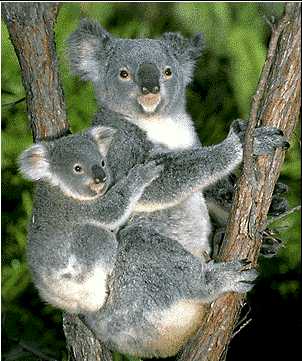Australian Koala Bears
|
Australian Koala bears a synonymous with Australia. However, the soft cuddly animals are an important part of indigenous Aboriginal culture too.
|
The Koalas were first discovered by John Price in 1798 and it was only in 1816 that they were given the scientific name Phascolarctos cinereus, meaning the ash grey pouched bear. When the European settlers moved to Australia, they used the Koala Bear as a source for fur and this resulted in millions of Australian koalas being shot. By 1924, Koalas were extinct in South Australia and their numbers seriously decreased in New South Wales and Victoria.
By late 1930s, public forced the government of each state in Australia to declare Koalas as protected species and this resulted in the increase in number of Koalas to a certain extent.
Today the Australian Koala bears are found living in the eucalyptus forests in Eastern and South-eastern Australia. The bears found in the south are 30 percent larger than those in the north.
The life expectancy of a Koala is approximately 17 years but the males live less than 10 years because of injuries sustained during fighting, or getting run down by cars or bitten and killed by dogs. Each year Australia loses 4,000 Koalas to cars and dogs.
Koalas live in societies and socially stable koala population is only possible the main food tree species is present. They live on a diet of eucalyptus leaves and seldom drink water. Their water need is fulfilled by eating the leaves, which is 50 percent water. They eat leaves and bark of 12 different species of eucalyptus trees. In addition, they also eat mistletoe and box leaves. They have a slow metabolic rate and eat approximately 200 grams to 500 grams of leaves each day.
They are on the move after sunset after spending the entire day sleeping. In fact, a Koala spends nearly 75 percent of its time sleeping. Sleeping is strategy to conserve energy as their diet is low in nutrients but high in fiber content.

|
